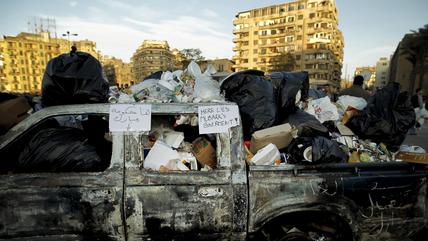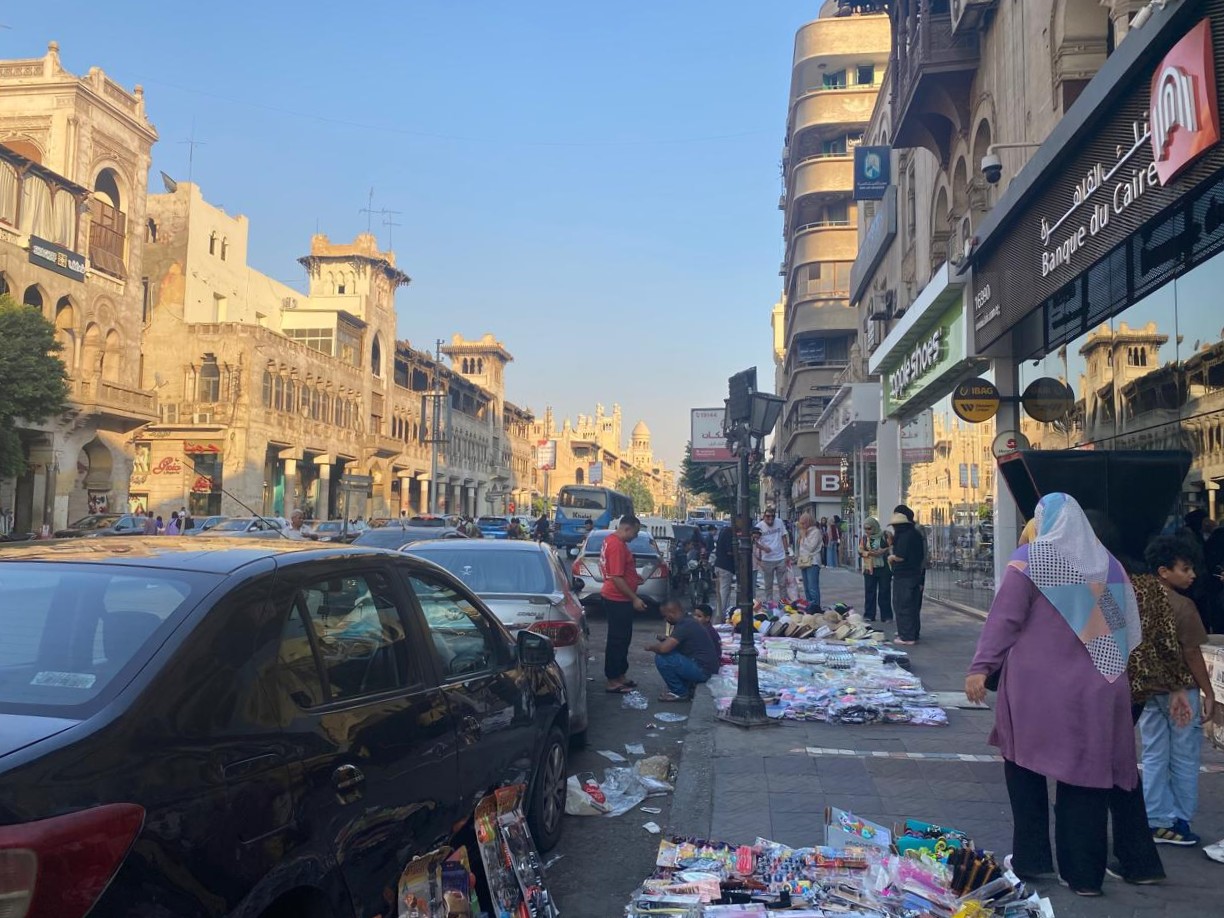Cairo is becoming unwalkable

Ten months ago, I was lucky enough to visit the Spanish capital, Madrid, for a three-day training programme. It was my first time travelling outside Egypt. A few months later, I travelled to Tunisia. After both trips, I realised that I didn't hate walking, as I had always told my father when he encouraged me to do it to save money or for my health. Walking only feels like a burden to me on Cairo's streets.
I was born into a lower-middle-class family in Gamaliya, historic Cairo, home to Al-Azhar Mosque and just a kilometre from the historic Al-Hussein Mosque. As a child, I often walked from my grandfather's house to Al-Hussein Mosque, winding through narrow streets and alleys that, though tight, radiated comfort and history. We would arrive at the mosque, which was shrouded in an aura of mystery and tranquillity.
I told my husband many times about these walks and recently took him to retrace them. We left my grandfather's house, walked through the same alleys, but they no longer gave me the same comfort. I was put on edge by the countless delivery drivers on bicycles who filled the streets. Their numbers have swelled due to rising unemployment, encroaching on pedestrian space. One of them almost ran us over during our walk.

"The Cairo I've known is being eroded"
Youssef Rakha revisits Egypt's 2011 uprising and its aftermath in "The Dissenters", the author's first novel written in English. The Arab Spring failed, he argues in this interview, because it was a neoliberal movement with no compelling vision for the future.
We arrived at Al-Hussein Mosque, now surrounded by black iron fences since a redevelopment project was announced by President Abdel Fattah el-Sisi in December 2022. The project prioritised security over the beauty once enjoyed by pedestrians in the area. The pleasure of gazing up at the mosque's dome and intricate architecture was gone. All that remains is a fence with gates that are locked except during prayer times.
In Omraniya, Giza, where I lived until recently, life changed after the government opened the Kamal Amer Bridge in March 2023. The bridge split the neighbourhood in two for roughly three kilometres, with only two pedestrian crossings—neither near my home. During the years-long construction process, we had to deal with road diversions, erratic traffic and stifling congestion. Now that the bridge is operational, it may offer me convenience as a driver, but for my family and other residents, it has become a concrete barrier, cutting neighbours off from one another.
Many people risk their lives crossing the bridge, rather than taking the long detour to reach the pedestrian ramp. These pedestrians are constantly forced to dodge reckless tuk-tuks that often run them down, but they take the risk to save time, even if it endangers their lives. Once, while heading home to October Gardens via the Kamal Amer Bridge, I encountered the body of a man who seemed to have been run over, surrounded by security officers waving cars forward, instructing them to continue without stopping.
Traffic accidents occur almost daily in Egypt due to a range of factors, including the absence of traffic lights, poorly lit roads, reckless driving and a lack of police patrols. According to official statistics, 5,260 people were killed and more than 76,000 others were injured in traffic accidents in 2024.
Across social divides
While the Egyptian government invests heavily in new road projects, pedestrian access is consistently overlooked in its approach to city planning. This is even true in upscale urban areas such as Heliopolis, home to wealthier residents, let alone in my own working-class neighbourhood.
A paper published by the Nada Foundation for Safe Egyptian Roads (March 2023), titled "Heliopolis: Pedestrians and Mobility Infrastructure," reveals how bridges have divided the streets of Heliopolis, forcing pedestrians to use cars and public transport to get around their own neighbourhood instead of walking.
I hadn't been to Heliopolis in years, but I used to go there almost daily for my old job. Back then, it felt like the complete opposite of my neighbourhood, with wide open spaces and walkable streets. After reading the Nada Foundation's paper, I decided to return to Heliopolis—48 kilometres from my home—only to find it far more congested and more difficult to walk through.
The research paper defines walking, along with cycling, as a form of "active travel", linked to health benefits such as lower rates of hypertension and obesity. Citing World Health Organisation statistics, it notes that Egypt ranks 18th worldwide for overweight populations.
The paper states that 87% of daily trips in Greater Cairo (Cairo, Giza and Qalyub) were motorised, and only 13% were active (walking and cycling), out of a total of 25.6 million daily trips in 2014. I believe the percentage has decreased further now, with the growth of both public and private transportation.
The paper also contrasts Egypt with models that prioritise street use for pedestrians first, then cyclists, followed by bus users and, lastly, private cars. Despite efforts, such an approach has never been applied in Heliopolis or anywhere in Egypt.

In October 2022, the Cairo Governorate launched the bike-rental app Cairo Bike in an effort to encourage green transport in the capital. The experiment initially seemed promising, but within months its shortcomings became apparent. The designated bicycle lanes were not respected by vehicles, and violators were not held accountable. The lane markings soon disappeared under the wheels of cars.
As a bike enthusiast, I tried the app once and was disappointed. The bikes are not well-maintained, and riding them was difficult due to both their poor quality and the excessive traffic on the road, which was full of cars and pedestrians.
Trees and public spaces under threat
In Egypt, pedestrians are both the victims and the culprits. With few designated footpaths and little regard for traffic signals, the result is chaos and frequent accidents.
I remember in Madrid, I could walk briskly for over an hour, covering several kilometres, without any of the hassle or harassment I often faced on Cairo's streets. Downtown Cairo may share some architectural similarities with Madrid, but its beauty is dulled by layers of dust, and its streets are crowded with vendors, people asking for money, and photographers offering quick snapshots as you cross the Qasr el-Nil Bridge.

Debt on the Nile
For leading economist Yazid Sayegh, the cause of Egypt's current economic and financial crisis lies primarily in the government's policy of excessive borrowing. He also criticises the way German and European politicians handle the Sisi regime. Interview by Mahmoud Hussein
In Madrid, I saw how a city can prioritise pedestrians: wide, paved sidewalks—almost as wide as the space given to cars—interspersed with benches every few metres. Side streets were designated exclusively for walking, lined with green spaces and trees, which are cut down here in Cairo.
The open space outside Cairo University, once a vital gathering spot for families, was erased to make way for investment projects and new roads. Parks and trees have fallen victim to policies that prioritise profit over environmental balance. Today, in a country that is 96% desert, we are already witnessing the consequences.
The way Egyptians walk has changed. Shrinking parks have been replaced by enclosed malls. With summer temperatures averaging 38°C and humidity exceeding 60%, walking outside feels punishing, and air-conditioned malls offer relief.
This refuge—one that I, like many middle- and lower-class Egyptians, have come to accept—was once the preserve of the upper classes, who sought seclusion among international brand stores as an escape from the harsh realities of Cairo's streets.
This is an edited translation of the Arabic original. Translated from Arabic by Maram Taylor.
© Qantara.de